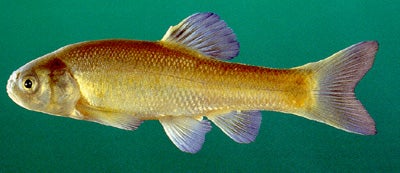FATHEAD MINNOW
SCIENTIFIC NAME: Pimephales promelas
CHARACTERISTICS: Pimephales promelas is the most popular bait minnow in the country. Along with the golden shiner, Notemigonus crysoleucas, this minnow accounts for most of the live bait sold. Body form is stout and flat sided, with a short, round snout and rounded fins. Like the bluntnose minnow, P. notatus, the fathead minnow has a broad, flat back with small scales. The tail spot is faint or often absent on a gray to silvery gray body. The mouth is more oblique and is the distinguishing character for separating this minnow from other Pimephales species. During the spawning season, the nape area behind the head of breeding males swells markedly.
ADULT SIZE: 1.6 to 3.9 in (40 to 100 mm)
DISTRIBUTION: Fathead minnow’s original occurred throughout the Midwest and upper Mississippi River drainages, west to Utah, north to Great Slave Lake in Canada, and east to Maine. They have also been introduced extensively throughout North America. Because this species is not native to Alabama, all of the collection locations shown on the facing page are either assignable to bait-bucket introductions or to accidental losses from bait farms.
HABITAT AND BIOLOGY: In its native range, this species is reported to prefer pools of small, intermittent prairie streams and to tolerate high temperatures, turbidity, and low dissolved oxygen concentrations. Its diet consists of plant material, algae, microcrustaceans, and sometimes aquatic insects. Like the bluntnose minnow, P. promelas, deposits eggs on the underside of submerged objects, with spawning occurring from May to August. Not only does the fathead minnow provide the bulk of bait minnows sold in the United States, but its young are also used as organisms for standardized testing in aquatic toxicology. Permits for wastewater discharge require that effluents not be toxic to aquatic life in the streams that will receive waste. The aquatic toxicity test uses the sensitive young of this species to measure the level of toxins, and the test has become a national standard followed by all municipalities and industries that use waterways for waste disposal.
ORIGINAL DESCRIPTION: The fathead minnow was described by Rafinesque in 1820.
ETYMOLOGY:
Pimephales means fat head.
Promelas means "forward" and "black," referring to the black head of breeding males.
The copyrighted information above is from Fishes of Alabama and the Mobile Basin.






